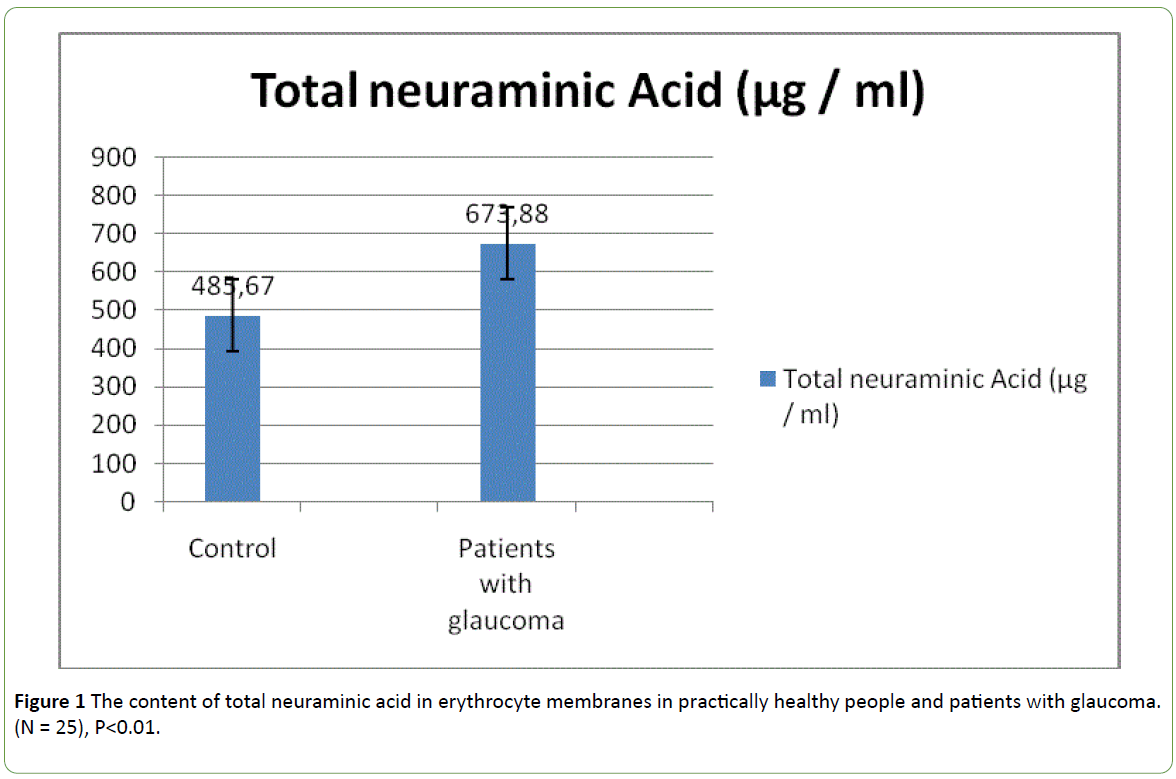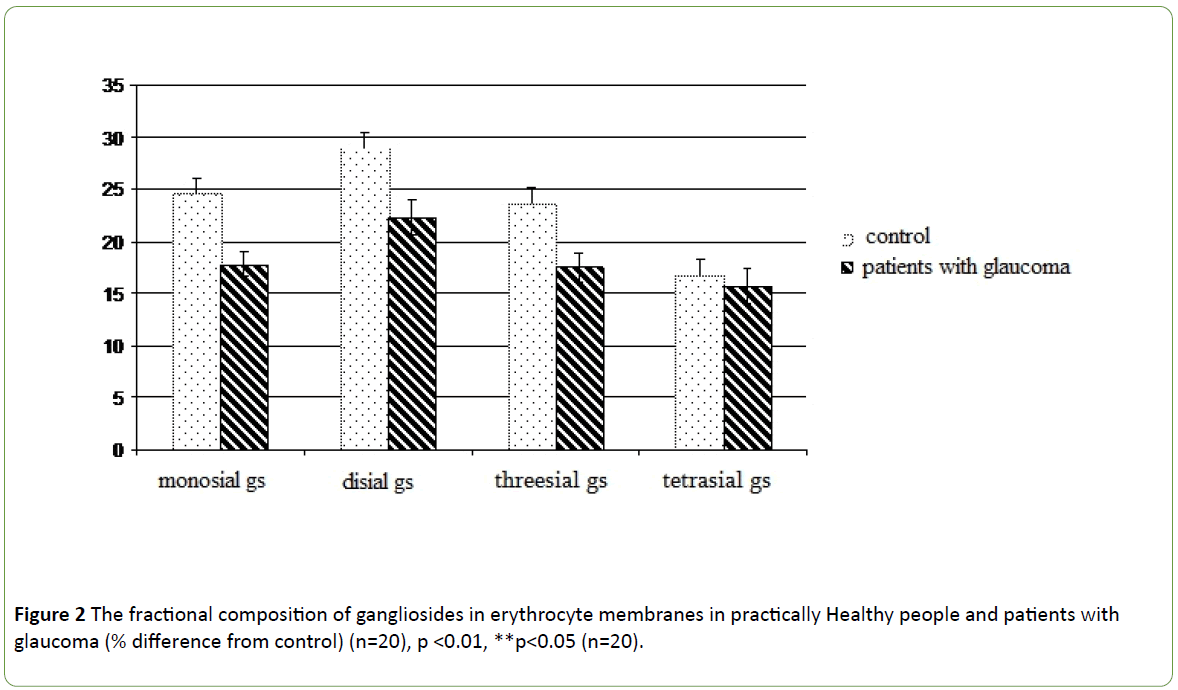Hovsepyan L, Ghazaryan G and Hasmik Zanginyan*
Institute of Molecular Biology (IMB) of the National Academy of Sciences of the Republic of Armenia (NAS RA), Yerevan, Armenia
Corresponding Author:
Dr. Hasmik Zanginyan
Institute of Molecular Biology (IMB) of the National Academy of Sciences of the Republic of Armenia (NAS RA), Yerevan, Armenia
Tel: +374 10 527031
E-mail: h_zanginyan@mb.sci.am
Received Date: March 15, 2017; Accepted Date: March 22, 2017; Published Date: March 29, 2017
Citation: Hovsepyan L, Ghazaryan G, Zanginyan H. The study of the content of N-acetylneuraminic acids in membranes of erythrocytes in patients with glaucoma. J Biomedical Sci 2017, 6:2. doi: 10.4172/2254-609X.100059
Copyright: © 2017 Hovsepyan L, et al. This is an open-access article distributed under the terms of the Creative Commons Attribution License, which permits unrestricted use, distribution, and reproduction in any medium, provided the original author and source are credited.
Keywords
Glaucoma; Erythrocyte membrane; Gangliosides; Neuraminic acid
Introduction
Glaucoma is one of the main causes of blindness and vision impairment, despite the obvious successes in the diagnosis and treatment of this disease.
Risk factors affecting the incidence of glaucoma include older age, heredity (glaucoma in close relatives), diabetes, disorders of glucocorticoid metabolism, arterial hypotension. Glaucoma is characterized by increased intraocular pressure (IOP), leading to a disruption in the outflow of intraocular fluid in the eye and optic nerve, which leads to the death of the neurons of the eye. The etiology of glaucoma is associated with ischemia and the development of neurodegenerative processes. A large number of studies have shown that glaucoma has a close relationship with systemic cardiovascular pathology on the one hand [1], on the other, some researchers indicate the presence of close connections of primary glaucoma with such neurodegenerative diseases as Alzheimer's disease and Parkinson's disease [2,3].
Numerous researchers believe that the main mechanism underlying the progression of glaucoma, even when the level of IOP is stabilized, is apoptosis. The death of retinal ganglion cells in glaucoma develops against the background of activation of apoptosis. It is believed that by apoptosis, 5,000 ganglion cells per year die in the eye, with glaucoma this number may be doubled [4,5]. Apoptosis is characterized by the obligatory destruction of neuronal membranes, leading to a disruption of cellular functions.
One of the main components of the membranes is glycoproteins and gangliosides. These compounds in their structure contain a carbohydrate component and participate in the processes of transmembrane transport, intercellular contact, signal transmission processes are associated with them (receptor and non-receptor tyrosine kinases, cellular antigens, adhesion molecules), participate in synaptic transmission, receptor reactions, formation and storage of memory. The main role in these processes is attributed to the presence in their structure of neuraminic acids.
Neuraminic (sialic) acids are polyfunctional compounds with strong acid properties. As a rule, they are not found in the free form, they are included in the composition of various carbohydrate-containing substances, such as glycoproteins, glycolipids (gangliosides), oligosaccharides. Occupying the end position in the molecules of these substances, neuraminic acids have a significant effect on their physicochemical properties and biological activity.
Some authors indicate that the content of N-acetylneuraminic acid can be used as a biochemical marker of apoptotic and necrotic damage [6,7]. Based on the foregoing, we conducted a comparative study of the total and lipid-bound neuraminic acid content in erythrocyte membranes in glaucoma. Complex evaluation of the content and composition of total and lipidbound neuraminic acid in glaucoma in erythrocyte membranes can be useful for understanding the pathogenetic features of this disease.
Material and Methods
Experiments were carried out in blood erythrocyte membranes of patients with glaucoma who are being treated in the eye clinic. All patients underwent a standard ophthalmologic examination.
Membranes of red blood cells were isolated from the erythrocyte mass, which was washed with an isotonic NaCl solution. The washed erythrocyte mass was suspended in a buffer solution (0.01 M NaHCO3, 0.003 M NaCl, EDTA) followed by centrifugation at 12000 g on a K-24 centrifuge [8]. To determine the total neuraminic acid, the protein-free filtrate of erythrocyte membranes underwent hydrolysis, resulting in the release of neuraminic acids from the sialoglycoproteins, which, when reacted with acetic and sulfuric acids, lead to the formation of a colored compound at elevated temperatures [9]. Lipid-bound neuraminic acid is mainly found in gangliosides, so we determined its content in gangliosides. To determine lipidbound sialic acid in erythrocyte membranes, extraction was carried out with a methanol-chloroform mixture (1: 2). The supernatant with the lipids extracted therein was collected and the pellet was reextracted three times. To the combined lipid extract, cold distilled water (in the amount of 1/5 of the total extract) was added, the mixture was thoroughly mixed and centrifuged (at 3000 rpm for 10 minutes). The lower chloroform layer consisting of phospholipids and neutral glycosphingolipids was separated from the upper aqueous methanol layer containing the glycolipids by centrifugation.
The upper aqueous methanol layer was dialyzed against distilled water for 2 days at 4°C, with a frequent change of water in the dialyzer.
The dialysis solution obtained after dialysis was evaporated on a rotary evaporator and applied to a column with DEAESephadex A-25. Gangliosides were determined by thin-layer chromatography in a solvent system chloroform: methanol: 2.5 M ammonia (60: 35: 8). The content of GB was judged by the amount of N-acetylneuraminic acid, which was determined by the resorcinol method [10].
The data obtained were processed statistically using Student's test.
Results and Discussion
As the results of the study show (Figure 1), an increase in the total neuraminic acid content is observed in membranes of blood erythrocytes in patients with glaucoma. At present, it has been established that the erythrocyte membrane in its structure and functions is identical to the membranes of the cells of the body as a whole and, in this connection, can serve as a convenient and accessible object for the study of disturbances in membranes. Normally, as a rule, in free form, neuraminic acids are found in a small amount. The total level of neuraminic acids freely circulating in the bloodstream is the sum of the released neuraminic acids as a result of the breakdown of glycoproteins and glycolipids. As a result of hydrolytic decomposition, its content rises, which is associated with the process of sialing and desialization of proteins and glycolipids in the body.

Figure 1: The content of total neuraminic acid in erythrocyte membranes in practically healthy people and patients with glaucoma. (N = 25), ?<0.01.
Cleavage of N-acetylneuraminic acid from glycolipids and glycoproteins occurs by the enzyme neuraminidase (sialidase). Eliminating neuraminic acid from the components of cell membranes, this enzyme changes the structure and overall charge of the membrane. Studies in recent years show that neuraminidase, associated with the plasma membrane of the cell, has an important physiological significance for the cells of the human nervous system. Neuraminidase changing the qualitative and quantitative composition of glycoproteins and gangliosides in cell membranes modulates the activity of protein kinases, and, consequently, the reaction of the cell to certain signals that lead to the phosphorylation of a number of proteins, which stimulates or reduces the transcription of certain genes. Some authors suggest that neuraminidase localized in the plasma membrane is able to directly activate the receptor for tyrosine kinase A, cleaving off the sialic acid residue [11,12].
Proceeding from the fact that the gangliosides contain lipidbound neuraminic acid, we investigated the content of gangliosides in erythrocyte membranes. As the results of the study, shown in Figure 2. Gangliosides of erythrocyte membranes are represented by 4 fractions of gangliosides: monosyalans, gangliosides, trisialgs and tetrasial gangliosides, differing in the content of neuraminic acids in them. As the results of the study showed, glaucoma reflected in Figure 2 is characterized by a decrease in the content of all fractions of gangliosides. It is believed that mono- and disial G3 have a high exchange rate, while tri- and tetrasialgs are characterized by a lower exchange rate. All the structural changes in GB due to desialization, primarily affect the charge and affect the electrogenic nature of the membranes, which affects the conduction of nerve impulses in neurons and the regulation of this process. In patients with glaucoma, a decrease in the content of all fractions of gangliosides in erythrocyte membranes is observed.

Figure 2: The fractional composition of gangliosides in erythrocyte membranes in practically Healthy people and patients with glaucoma (% difference from control) (n=20), p <0.01, **p<0.05 (n=20).
As already noted, the total concentration of neuraminic acids in the membranes of erythrocytes in glaucoma is increased.
As already noted, an increase in the level of neuraminic acids in biological fluids reflects the processes of destruction of membrane structures of the brain tissue. Some researchers believe that the content of N-acetylneuraminic acid can be used as a biochemical marker of apoptosis and necrotic damage [6]. An increase in the content of N-acetylneuraminic acid in the cisospinal fluid of patients with strokes is shown, the high content of N-acetylneuraminic acid on the first day correlates with the severity of the patients' condition and the vastness of the ischemic zone of the brain [7] and reflects the intensity of the processes of destruction of neuronal membranes accompanying necrotic damage. In addition, it is known that in membranes gangliosides can be cleaved to ceramide and sphingosine, which induce apoptosis, and inhibit cell proliferation. It seems to us that an increase in the content of free sialic acids in the blood plasma and erythrocyte membranes may be the reason for the cleavage of neuraminic acids from glycoproteins and gangliosides.
It is worth mentioning the fact that the protective effect of GM1 on neurons of the retina in optic nerve trimming is studied. These authors found that the introduction of GM1 protects retinal neurons from death and leads to an increase in the level of pERK1/2 and pCREB (transcription factor).
Thus, the results of our study revealed a role for Nacetylneuraminic acids in the pathogenesis of glaucoma development.
18662
References
- Barot M, Gokulgandhi MR, Mitra AK (2011) Mitochondrial dis¬function in retinal diseases. Curr Eye Res 36: 1069-1077.
- Bizrah M, Guo L, Cordeiro MF (2011) Glaucoma and Alzheimer's disease in the elderlyAging Health 5: 719–773
- Cordeiro MF , Migdal C, Bloom P, Fitzke FW, Moss SE (2011) Imaging apoptosis in the eye. Cambridge Ophthalmological Symposium Eye 25: 545–553.
- Lacombe R, Salcedo J, Algeria A, Lagarda MJ, Barbera R, et al. (2010) Determination of Sialic Acid and Gangloisides in Biological Samples and Dairy Products. J Pharm Biomed Anal 51: 346–357.
- Woronovicz A, Amith SR, Vusser DK (2007) Dependence of neurotrophic factor activationofTrk tyrosine kinase receptors on cellular sialidase. Glycobiology 17: 10–24.
- Alekseev VN, Gazizova IR, (2012)Neurodegenerative changes in patients with primary open-angle glaucoma.Practice. Medicine 4: 154–156.
- Vlasova YUA, Zakharova IO, Sokolova ??TV, Avrova NF (2013)The metabolic effects of GM1 ganglioside on PC12 cells under oxidative stress depend on the modulation of the activity of the Trk receptor tyrosine kinase. J Evol Biochem And physiol 49: 15-23.
- Gusev EI,Skvorcova VI (2001)Ischemia of the brain. Moscow: Medicine328.
- Martynova EA (2012)General ideas about the role of sphingolipids in the signal pathways of apoptosis. Pathogenesis1: 16-28.
- Novitsky VV, Ryazantseva NV, Stepova EA(1997)Molecular disturbances of the erythrocyte membrane in pathologies of different genesis are a typical reaction of the organism: contours of the problem. Bulletin of Siberian Medicine 2: 62-69.
- Prohorova MI (1982)Methods of biochemical research. Leningrad: Leningrad University Press, p: 272.
- Frolov MA, Slepova OS, Morozova NS, Lovpache DN,Frolov AM(2013) The role of apoptosis in the pathogenesis of glaucoma lesion of the optic nerve with primary open-angle glaucoma. Ophthalmology4: 5-10.







